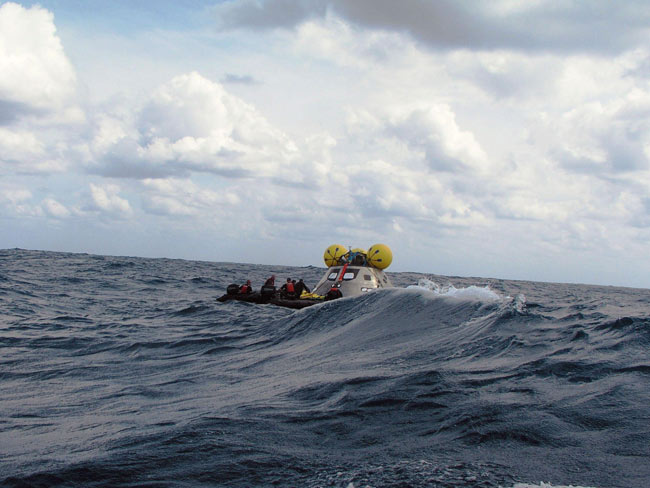NASA's New Moonship Takes Ocean Plunge

For thefirst time since the Apollo era, NASA is testing a new moonship in theturbulent waves of the open ocean.
Thelife-size mockup of the Orion Crew Exploration Vehicle, NASA?sreplacement for its retiring space shuttle fleet, is undergoing a series ofwater landing trials this month in the Atlantic Ocean off the eastern coast ofcentral Florida. They are the first ocean tests of a full-size NASA spacecraft sincethe Apollo capsule's development in the 1960s.
During thetests, teams of divers and engineers are practicing recoverytechniques to retrieve an Orion capsule after splashdown, as well astesting how the spacecraft performs in open water. The sea trials are the firstin which recovery teams attempted to attach a flotation collar around the Orioncraft while it bobbed up in down with the ocean waves.
?They?re lookingfor different types of sea conditions so they can report back how the capsulebehaves,? NASA spokesperson Amber Philman told SPACE.com from the agency?sKennedy Space Center (KSC) in Cape Canaveral, Fla. Philman said the tests,which are based out of nearby Port Canaveral, are being performed about 20 miles (32 km) off the Floridacoast, with three more days? worth of trials still on tap.
The Orioncrew capsule is NASA?splanned replacement for its three aging space shuttles, which are due toretire at the end of next year. Orion capsules are designed to launchatop a new rocket, the Ares I, and ferry six astronauts to theInternational Space Station or carry a four-person crew to the moon and back. The18,000-pound (8,164-kg) capsule is about 15 feet (4.5 meters) wide and largerthan the older Apollo capsules.
Like Apollocapsules, Orion vehicles are designed to re-enter the Earth?s atmosphere behinda protective heat shield and parachuteto a water splashdown. Earlier this month, NASA announced it will use an Avcoatablator material similar to that used during on Apollo for the Orion spacecraft.NASA currently plans to launch the first operational Orion flight in 2015 andis targeting the first manned moon shot by 2020.
- Video - Mock Orion Capsule Crashes to Earth
- Video - Back to the Moon with NASA's Constellation
- Video - NASA's Constellation Journey Begins - Part 1, Part 2
Get the Space.com Newsletter
Breaking space news, the latest updates on rocket launches, skywatching events and more!
Join our Space Forums to keep talking space on the latest missions, night sky and more! And if you have a news tip, correction or comment, let us know at: community@space.com.

Tariq is the Editor-in-Chief of Space.com and joined the team in 2001, first as an intern and staff writer, and later as an editor. He covers human spaceflight, exploration and space science, as well as skywatching and entertainment. He became Space.com's Managing Editor in 2009 and Editor-in-Chief in 2019. Before joining Space.com, Tariq was a staff reporter for The Los Angeles Times covering education and city beats in La Habra, Fullerton and Huntington Beach. In October 2022, Tariq received the Harry Kolcum Award for excellence in space reporting from the National Space Club Florida Committee. He is also an Eagle Scout (yes, he has the Space Exploration merit badge) and went to Space Camp four times as a kid and a fifth time as an adult. He has journalism degrees from the University of Southern California and New York University. You can find Tariq at Space.com and as the co-host to the This Week In Space podcast with space historian Rod Pyle on the TWiT network. To see his latest project, you can follow Tariq on Twitter @tariqjmalik.









